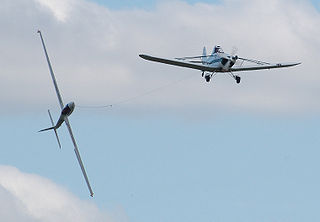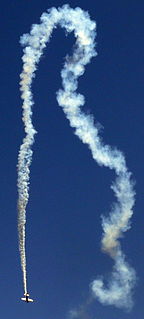
In fluid dynamics, a stall is a reduction in the lift coefficient generated by a foil as angle of attack increases. This occurs when the critical angle of attack of the foil is exceeded. The critical angle of attack is typically about 15 degrees, but it may vary significantly depending on the fluid, foil, and Reynolds number.
A spin is a special category of stall resulting in autorotation about the vertical axis and a shallow, rotating, downward path. Spins can be entered intentionally or unintentionally, from any flight attitude if the aircraft has sufficient yaw while at the stall point. In a normal spin, the wing on the inside of the turn stalls while the outside wing remains flying. It is possible for both wings to stall, but the angle of attack of each wing, and consequently its lift and drag, are different. Either situation causes the aircraft to autorotate toward the stalled wing due to its higher drag and loss of lift. Spins are characterized by high angle of attack, an airspeed below the stall on at least one wing and a shallow descent. Recovery and avoiding a crash may require a specific and counter-intuitive set of actions.

Aircraft flight control surfaces are aerodynamic devices allowing a pilot to adjust and control the aircraft's flight attitude.
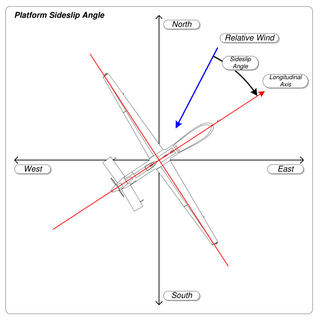
A slip is an aerodynamic state where an aircraft is moving somewhat sideways as well as forward relative to the oncoming airflow or relative wind. In other words, for a conventional aircraft, the nose will be pointing in the opposite direction to the bank of the wing(s). The aircraft is not in coordinated flight and therefore is flying inefficiently.
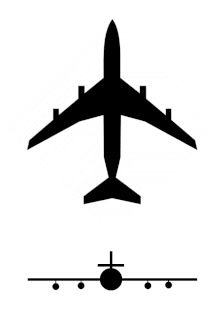
Dutch roll is a type of aircraft motion, consisting of an out-of-phase combination of "tail-wagging" and rocking from side to side. This yaw-roll coupling is one of the basic flight dynamic modes. This motion is normally well damped in most light aircraft, though some aircraft with well-damped Dutch roll modes can experience a degradation in damping as airspeed decreases and altitude increases. Dutch roll stability can be artificially increased by the installation of a yaw damper. Wings placed well above the center of gravity, sweepback and dihedral wings tend to increase the roll restoring force, and therefore increase the Dutch roll tendencies; this is why high-winged aircraft often are slightly anhedral, and transport-category swept-wing aircraft are equipped with yaw dampers.
Flight mechanics are relevant to fixed wing and rotary wing (helicopters) aircraft. An aeroplane, is defined in ICAO Document 9110 as, "a power-driven heavier than air aircraft, deriving its lift chiefly from aerodynamic reactions on surface which remain fixed under given conditions of flight".

Basic fighter maneuvers (BFM) are tactical movements performed by fighter aircraft during air combat maneuvering, to gain a positional advantage over the opponent. BFM combines the fundamentals of aerodynamic flight and the geometry of pursuit, with the physics of managing the aircraft's energy-to-weight ratio, called its specific energy. Maneuvers are used to gain a better angular position in relation to the opponent. They can be offensive, to help an attacker get behind an enemy or defensive, to help the defender evade an attacker's air-to-air weapons. They can also be neutral, where both opponents strive for an offensive position or disengagement maneuvers, to help an escape. Awareness is often taught as the best tactical defense, removing the possibility of an attacker getting or remaining behind the pilot; even with speed a fighter is open to attack from the rear.

A barrel roll is an aerial maneuver in which an airplane makes a complete rotation on both its longitudinal and lateral axes, causing it to follow a helical path, approximately maintaining its original direction. It is sometimes described as a "combination of a loop and a roll." The g-force is kept positive on the object throughout the maneuver, commonly between 2–3 g, and no less than 0.5 g. The barrel roll is commonly confused with an aileron roll.
The term Immelmann turn refers to two different aircraft maneuvers:
The Scissors is an aerial dog fighting maneuver commonly used by military fighter pilots. It is primarily a defensive maneuver, used by an aircraft that is under attack. It consists of a series of short turns towards the attacking aircraft, slowing with each turn, in the hopes of forcing the attacker to overshoot. Performed properly, it can cause the attacking aircraft to move far enough in front to allow the defender to turn the tables and attack.

In aviation, a crosswind landing is a landing maneuver in which a significant component of the prevailing wind is perpendicular to the runway center line.
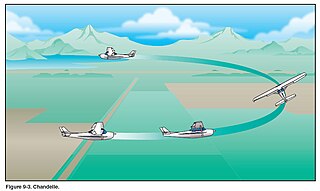
The chandelle is an aircraft control maneuver where the pilot combines a 180° turn with a climb.

Radio-controlled aerobatics is the practice of flying radio-controlled aircraft in maneuvers involving aircraft attitudes that are not used in normal flight.
Supermaneuverability is a term used to describe the capability of fighter aircraft to execute tactical maneuvers that are not possible with purely aerodynamic mechanisms. Such maneuvers can use controlled side-slipping and angles of attack beyond maximum lift.
3D Aerobatics or 3D flying is a form of flying using flying aircraft to perform specific aerial maneuvers. They are usually performed when the aircraft had been intentionally placed in a stalled position.
A wingover is an aerobatic maneuver in which an airplane makes a steep climb, followed by a vertical flat-turn. The maneuver ends with a short dive as the plane gently levels out, flying in the opposite direction from which the maneuver began.

A falling leaf is an aerobatic maneuver in which an aircraft performs a wings-level stall which begins to induce a spin. This spin is countered with the rudder, which begins a spin in the opposite direction that must be countered with rudder, and the process is repeated as many times as the pilot determines. During the maneuver, the plane resembles a leaf falling from the sky; first slipping to one side, stopping, and then slipping to the other direction; continuing a side-to-side motion as it drifts toward the ground.


